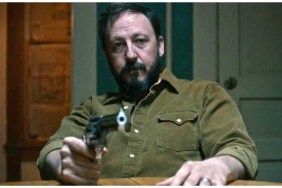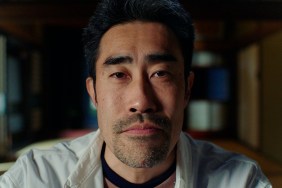Guillermo’s new movie Pan’s Labyrinth takes him further away from the horror genre and more into the world of fantasy and the fairy tales of his youth. Like The Devil’s Backbone, the story is set in Spain, taking place five years after the end of the Spanish Civil War. A young impressionable girl named Ofelia moves with her pregnant mother into the mansion of the military’s fascist captain, trying to rid the area of rebels, but the girl escapes from that brutal reality into a fairy tale world where she must fulfill three tasks to take back her place as princess of the underworld. The film’s visuals are amazing, far beyond del Toro’s previous films, and it features a lot of unknown Spanish actors like the amazing young Ivana Baquero, but it’s another amazing film that’s already gotten Mexico’s seal of approval when they put it forth as their entry to the Oscars.
ComingSoon.net had a chance to talk with this innovative filmmaker during his never-ending press tour for Pan’s Labyrinth, which included a prestigious closing night slot at the 44th New York Film Festival.
ComingSoon.net: What was the biggest difference between working on “Pan’s Labyrinth” than making “The Devil’s Backbone”?
Guillermo del Toro: I can tell you, the financing came up faster with this one than it did “Devil’s Backbone.” I remember “Devil’s Backbone ” took the Almodovar Brothers and us a year and a half to put together the money. This one, we got together the money pretty rapidly, but the structure to create the movie was more complicated, because we wanted to do a dual nationality movie, Mexico/Spain, and we needed to keep the balance of creative people behind and in front of the camera from both countries. It was complicated.
CS: And this one you did with Alfonso Cuarón, rather than with Pedro.
Del Toro: Yes, Pedro and his company were already busy with “Volver” so I knew from experience, El Deseo is great to work with in between Pedro films, but I would not tax them with a movie of mine while they’re doing a movie by Pedro, you know?
CS: You’ve mentioned that some of the ideas for this movie came from your childhood and this idea was brewing for a long time. I noticed that some of those ideas were present in “Hellboy,” images like the blood maze. Were those ideas you had since childhood?
Del Toro: No, no, no. No, I remember thinking when I did the “Hellboy” maze, I wanted just a graphic representation of a ritual, and I thought, “Well, I hate hieroglyphics on the floor, so what about a labyrinth and filling it with blood?” But I had no idea I would use it again, and I had no idea I would use it again with blood. It’s not deliberate. These are just images in my head that maybe repeat each other in different permutations, but they do repeat each other echoing.

Del Toro: That has happened in the past, of course, for sure. For example, the idea of her revealing him with the umbrella in the sequence. That has been in my notebook since 1993, and I wrote it originally for a movie called “Mephisto’s Bridge.” There is that, but in this case, it didn’t happen like that.
CS: You’ve mentioned that you collect fairy tales, so what kind of stuff, like original editions of Brothers Grimm?
Del Toro: Yeah, I try. I collect first edition illustrated books by Tom Dulack and Arthur Rackham and so forth. I was fortunate enough to get my hands on about six or seven K. Nielsen originals, which I bought, but I haven’t been able to afford financially a Rackham, which they sell for very high prices. I have a couple of Edward Goreys and I collect first editions of Rackham, first editions of Dulack and K. Nielsen. I think these guys are brilliant, and on top of that, I have fairy tales from India, from Native Americans, from Romania, from everywhere. I collect oral fairy tales from most of the world.
CS: Did any of those fairy tales inspire this movie?
Del Toro: Yeah, for example, the frog nesting under a tree that’s rotting is a very, very usual image in a fairy tale. Or a frog clogging the waterways of a city and you have to kill it for the water to flow or kill it for the tree to flourish again, that’s very common in European folklore. The idea of a banquet where you should not eat or drink anything is very common, and it is repeated in many forms, such as in Aladdin, the cave of treasures, where you shall not steal anything, not a jewel, nothing. For example, the idea of the ogre, which is what the Pale Man is, eating kids and so forth, the idea of book, knives and keys being magical objects. It’s also from there. There is another thing that’s a little more abstract, which is called the “symmetry of the Three.” Which is three brothers, three tasks, three doors, three witches. In this, it’s three tasks, three doors that she must choose from and so on and so forth.
CS: Besides the Pale Man, which didn’t strike me as religious until you mentioned it, I was surprised that there was very little religion or spirituality among the characters in the movie.
Del Toro: There is the priest that is eating at the dinner, and the priest sayswhich is taken verbatim from a priest saying itwhen he says “God already saved their souls; what happens to their bodies matters not him.” I got it from a documentary and a priest actually said that for people that were going to get shot the next morning.
CS: Still, you would think there would be some sort of praying, whether it be the pregnant mother or the maid, just because of their situation.
Del Toro: No, no, no, because most of rural Spain was divided neatly between people that were very Republican and every left wing and hated prayer and people who were too religious. I think that there’s also a little bit, the priest at the funeral is extolling the virtues of Catholicism and saying things about God and so forth, and finally, some people may be tempted to think SPOILER goes to a version of heaven at the end, but I disagree with that one.
CS: The Pale Man scene would make it seem like Ofelia comes from a very religious background.
Del Toro: No, and I think that you can see that the symmetry is very neat, because the banquet occurs in her house first, and then she goes to the Pale Man.

Del Toro: No, no, no. I remember showing it to a very famous director in Hollywood and I asked what he thought, and he said, “If you could cut down the violence, kids could see it” and I said, “No, that’s not the point, is it?” The point of the movie is mostly to be a fairy tale for grown-ups. I think some teenagers could easily handle the violence in the movie, but I would not admonish it as a general rule.
CS: I think teenagers might be able to handle the violence better than adults, since they’re used to that kind of stuff from video games and the like. You’ve been working a lot with kids, in this, “Devil’s Backbone”, “Hellboy” had a kid. Is that something you enjoy doing?
Del Toro: “Cronos”
“Mimic”
if you read interviews with me all the way back to “Cronos,” I say the following, “Kids are essential in the horror genre because the horror genre was born out of the fairy tale.” It needs the innocent point of view in order to go through the ordeal. Now I’m doing a straight fairy tale, so even moreso.
CS: And the next movie you do in Spain, will that be a similar type theme also involving kids?
Del Toro: No, “3993”, which is the next movie in Spain is essentially movie in which a character in 1993 says there’s nothing that interests that character out of the Civil War, and that character says, “It’s gone, it’s past, why are we dwelling on it?” And then something from 3993 is very much alive and comes after that character. It’s a very interesting fantasy.
CS: Why did you decide to set it in that particular year?
Del Toro: 1993 was the Olympic Pride in Spain, and nothing could be more removed from the big defeat of 1939.
CS: This is the third movie you did with Doug Jones, how do the two of you develop these characters he plays? You have a lot of ideas in your sketchbook but what does Doug bring to it as doing the character? Does he even speak Spanish or does he do it phonetically?
Del Toro: I started with Doug in “Mimic,” he played one of the bug guys, and I love working with him to such a point that I said, “Could you give me a card?” and he gave me a card. Then years later, when we used him for Abe Sapien, I just realized what a great actor this guy is. And I think he brings performance to the creature. He really is an actor, first and foremost, more than any other creature performer I’ve ever met.
CS: You sometimes forget that his characters aren’t CGI and that’s a real person doing all that.
Del Toro: Yeah, and he learned Spanish phonetically and then of course, we dubbed him.
CS: Wow, his timing coincided so perfectly that you couldn’t tell. Who did the voice of The Faun?
Del Toro: It was done by a dubbing actor in Spain that also plays the narrator of the film.
CS: Your movie has been submitted by Mexico as its nomination for the Oscars even though it’s a Mexico/Spain collaboration. Were you surprised or amazed when they went with it?
Del Toro: I was happy, because as I said, it’s something we fought very hard to maintain the balance of dual nationality, so I was very happy it happened.

Del Toro: (smiling) Let’s hope we have that problem.
CS: The story of Hellboy is interesting, because it got picked up by Sony and did okay, maybe better than some expected.
Del Toro: And starring Ron Perlman.
CS: Right, I’m a huge fan of his, too. The fact that you’re doing a sequel with a different company is pretty amazing, since that almost never happens. How did you manage that?
Del Toro: Because we don’t give up. We just persist and Larry Gordon never gives up. We pursued it, and both times [Hellboy creator Mike] Mignola is absolutely sure it’s not going to happen, then it happens.
CS: So you just have to make sure that Mignola is down on something for it to happen.
Del Toro: Exactly, as long as Mignola gives up on it, it happens. I knew our time had come when Mike said, “Well, if it doesn’t happen now, it will never happen” which is what we said on the first one and then it happened.
CS: The first movie had elements from the Mike’s first mini-series, but I assume the sequel will be something new and different or will that also be based on one of the stories?
Del Toro: Funny enough, Mike says that he’s including some of the storyline of the sequel in the present series. He said it’s a coincidence and he was moving into that direction already, so it’s a blessing. We’re going to have sort of a thematic continuity on the movie.
CS: How do the two of you work on this. With the comics, you at least have a visual reference. Are you able to write things and then have him draw them up or do you work on it together?
Del Toro: No, I worked on the story and then I went away for almost two years and wrote the screenplay and came back with the screenplay completed and now that we’re in the design phase, we sit together, we draw for days and days and days, then he’s going to be gone and he’ll come back during production.
CS: For the new “Hellboy” movie, are you going to be incorporating more of the BRPD characters into it or will it focus more on Hellboy?
Del Toro: Johann Krauss comes in and other than that, and literally, we can’t afford any more agents, cause Johann is already an expensive character, the ectoplasmic guy. What we do have is a better gallery of villains than the last one. Mistakes were made in, for instance, killing Kroenen too early. He was such a good character, he should have died last, you know? ‘Cause basically, the movie ends when Kroenen dies.
CS: Oh, I dunno. I liked the big Lovecraftian creature.
Del Toro: I like it too, but it’s not as satisfying as beating the crap out of Kroenen.
CS: Are you going to try to use some of the things you’ve learned making “Pan’s” as far as doing things on a smaller budget to that?
Del Toro: Yeah. The idea is to take “Hellboy” and then make it for a number close to the first one, but make it look two or three times the budget.
CS: You’ve been so connected to comics between “Blade,” “Hellboy” and your own work. Have you ever considered doing something in comic book form?
Del Toro: Yeah, yeah
I have actually a two comic book deal with Dark Horse, but I haven’t had the time. But I’ll do it.

Del Toro: Yeah, it would have been.
CS: So after making the “Hellboy” sequel, you’ll go right into that other Spanish movie?
Del Toro: Hopefully so. I don’t control it to that degree. With “Blade,” I did that and then I did “Hellboy” and then I did the Spanish movie, so maybe it’ll be one or two Americans and then I’ll go and do another Spanish one, I hope.
Because we love Guillermo and his movies so much, we have a bit more with him, taken from a roundtable interview he did earlier that day. Enjoy!
CS: In some ways, “Pan’s Labyrinth” is a fantasy movie for adults, so do you think there’s anything in this movie for kids?
Del Toro: I think if I were suddenly in charge of the entire parenting board, I would say up to a certain age I agree with you. I think there is a very perverse exercise in raising kids, where we on the one hand isolate them from violence that has any real weight and allow them to immerse themselves in violence that has no reality to it. On the one hand, you create children that are hyper-sensitive to adversity and pain, and you create children who are perversely addicted to the graphic nature of violence. I would say that up to a certain point, I would allow younger kids than the rating it has, in their early teens, but thank God I’m not in charge of the parenting board.
CS: In your two recent Spanish films, you have kids as the protagonists in turbulent times. Can we look at the fantasy elements of those movies as their way to escape reality into their own imaginations?
Del Toro: I actually think that fantasy is not an escape, but a way to articulate the world. I don’t think the girl is escaping, because if she was escaping, then she would escape like Sam Lowry in “Brazil,” flying or escape into a Disney World with little birds chirping and telling her how beautiful she is. When I was a kid, my imagination was never benign, but it helped me understand the world a little bit. It helped me articulate through fable, the good and the evil and the this and the that. It’s a clear way to find your place in the world. Now crazy enough for me, in the movie, it’s real.
CS: I’m glad to hear you mention “Brazil.” Were you at all influenced by the way Terry Gilliam mixes fantasy and reality in his movies?
Del Toro: I love “Brazil” very much. I think Terry Gilliam is one of the most brilliant filmmakers alive right now, and a guy who should be working so much more. I tell you, “Brazil” is one of those movies I saw and the world completely changed for me.
Pan’s Labyrinth opens in select cities on December 27.









